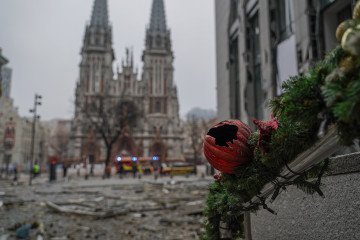- Category
- Opinion
1,000 Days Under Pressure of Restrictions: Successes and Gaps in Ukraine's and Its Partners' Sanctions Policy

Over 1,000 days since the full-scale invasion of Ukraine began, it has become evident that the sanction's policy of Ukraine's allied nations is as critical as the military component.
Russia has managed to boost its production to record levels not seen since Soviet times, leveraging technologies from Ukraine's allies and financing this war substantially with funds that still flow from entities conducting business in allied countries.
Today, many question the effectiveness of sanctions against the Russian Federation. This was a key topic of discussion ahead of the anniversary of the large-scale war at the Public Council on Sanctions. (This body unites 13 specialized organizations coordinated by Vladyslav Vlasiuk, the President's Commissioner for Sanctions Policy.)
Sanctions have undoubtedly weakened the Russian Federation significantly. At the same time, modern tools have enabled the circumvention or mitigation of certain restrictions. We have identified a conditional Top 5 successes and failures in sanctions policy, which largely go hand in hand.
Among the key achievements of sanctions pressure is the EU oil embargo. It came into force in winter 2022 and has become one of the most critical tools for reducing Russian budget revenues. In 2023, oil exports fell by 20%, and budget revenues from oil and gas dropped by 24%.
However, revenues from hydrocarbon sales remain the primary driver of Russian aggression and the principal source of its budget. European countries' dependence on pipeline oil still creates gaps that Russia actively exploits. Moscow has built a "shadow fleet" that transports about 90% of its crude oil. Currently, the EU is preparing a second sanctions package to expand the list of sanctioned vessels prohibited from transshipment. However, Russia's efforts to bypass sanctions have proven relatively effective.
Step by step, sanctions are reducing Russia's access to critical components from the EU and the US—those enabling Russian aircraft, missiles, and drones to take flight. These components have become significantly more expensive and less accessible, often replaced by Chinese alternatives. However, sanctions policy is far from perfect here as well. The absence of global export controls means imports through third countries continue to thrive. In 2023, these imports reached $27.6 billion, reflecting the success of sanctions evasion through China, Thailand, the UAE, and others.
Today, despite sanctions and supply bans, components from Ukraine's allied countries can be found in nearly every missile with which Russia continues its near-daily attacks on Ukrainian cities.
Sanctions successes include crises in Russia's strategic industries, such as aviation, machinery, coal, and timber. Also notable is the severing of access to Western assets for propagandists, oligarchs, and officials through individual sanctions. However, these restrictions often allow assets to be transferred to affiliated parties. Moreover, the absence of mechanisms for confiscating private sanctioned assets reduces the effectiveness of this type of sanctions.
The insufficient withdrawal of international businesses from Russia remains another significant problem, as many Western companies continue operating in Russia and paying taxes into the aggressor's budget. As of now, according to KSE Institute data, 2,197 international brands (54.9%) continue operating in Russia, while only 440 (11%) have completely exited the Russian market.
According to NAКO, gaps in partner sanctions policies stem, among other things, from a lack of capacity within partner governments to effectively implement their sanctions policies. The challenges posed by Russia, Iran, and North Korea are currently disproportionate to their capabilities. Our partners simply cannot fully cover all the needs of effective sanctions enforcement.
What requires particular attention today has been outlined in the so-called "Sanctions To-Do List" developed by the Public Council on Sanctions in collaboration with other members. This is a set of recommendations from Ukraine's civil society on sanction priorities for partner countries. It focuses on five key areas: access to strategic resources, access to critical technologies, energy and logistics, economic sanctions against legal entities and individuals, and monitoring the effectiveness of sanctions policies. Only through coordinated action by the international community can the effectiveness of sanctions be ensured and Ukraine’s victory brought closer.
Despite significant achievements, the sanction's policy requires substantial improvement. Future steps should include strengthening sanctions compliance monitoring, expanding international cooperation to eliminate gaps, and increasing economic pressure on the aggressor. Today, this is no longer just a matter for Ukraine, as Russia increasingly threatens the entire civilized world, largely using its technological advances to do so.
*The Public Council on Sanctions was created to coordinate the work of government and civil society representatives to jointly advocate for, implement, and update restrictions against Russia and its partners. It brings together the following organizations: the National Interests Advocacy Network “ANTS,” Black Sea News and the Institute for Black Sea Strategic Studies, DiXi Group, the Institute of Legislative Ideas, ICUV (International Center for Ukrainian Victory), KSE Institute, OSINT agency Molfar, the Independent Anti-Corruption Commission (NAKO), the Economic Security Council of Ukraine, the Global Studies Center “Strategy XXI,” StateWatch/TrapAggressor, Razom We Stand, and the NGO Ukrainian Analytical Center U8

-c42261175cd1ec4a358bec039722d44f.jpg)
-46f6afa2f66d31ff3df8ea1a8f5524ec.jpg)

-7e242083f5785997129e0d20886add10.jpg)
-cc5860059e044295cd5738becdb4e387.png)

-e27d4d52004c96227e0695fe084d81c6.jpg)
